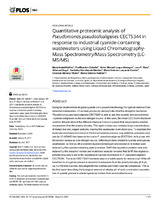Mostrar el registro sencillo del ítem
Quantitative proteomic analysis of Pseudomonas pseudoalcaligenes CECT5344 in response to industrial cyanide-contain ing wastewaters using Liquid Chromatography- Mass Spectrometry/Mass Spectrometry (LC- MS/MS)
| dc.contributor.author | Ibáñez, María Isabel | |
| dc.contributor.author | Cabello, Purificación | |
| dc.contributor.author | Luque-Almagro, Víctor Manuel | |
| dc.contributor.author | Sáez, Lara P. | |
| dc.contributor.author | Olaya-Abril, Alfonso | |
| dc.contributor.author | Sánchez de Medina, Verónica | |
| dc.contributor.author | Luque de Castro, M.D. | |
| dc.contributor.author | Moreno-Vivián, Conrado | |
| dc.contributor.author | Roldán, María Dolores | |
| dc.date.accessioned | 2017-03-07T10:05:17Z | |
| dc.date.available | 2017-03-07T10:05:17Z | |
| dc.date.issued | 2017 | |
| dc.identifier.uri | http://hdl.handle.net/10396/14585 | |
| dc.description.abstract | Biological treatments to degrade cyanide are a powerful technology for cyanide removal from industrial wastewaters. It has been previously demonstrated that the alkaliphilic bacterium Pseudomonas pseudoalcali genes CECT5344 is able to use free cyanide and several metal − cyanide complexes as the sole nitrogen source. In this work, the strain CECT5344 has been used for detoxification of the different chemical forms of cyanide that are present in alkaline wastewaters from the jewelry industry. This liquid residue also contains large concentration s of metals like iron, copper and zinc, making this wastewater even more toxic. To elucidate the molecular mechanisms involved in the bioremediation process, a quantitative proteomic anal- ysis by LC-MS/MS has been carried out in P . pseudoalcaligene s CECT5344 cells grown with the jewelry residue as sole nitrogen source. Different proteins related to cyanide and cyanate assimilation, as well as other proteins involved in transport and resistance to metals were induced by the cyanide-cont aining jewelry residue. GntR-like regulatory proteins were also induced by this industrial residue and mutational analysis revealed that GntR-like regulatory proteins may play a role in the regulation of cyanide assimilation in P . pseudoalcaligene s CECT5344. The strain CECT5344 has been used in a batch reactor to remove at pH 9 the dif- ferent forms of cyanide present in industrial wastewaters from the jewelry industry (0.3 g/L, ca . 12 mM total cyanide, including both free cyanide and metal − cyanide complexes). This is the first report describing the biological removal at alkaline pH of such as elevated concentra- tion of cyanide present in a heterogeneou s mixture from an industrial source. | es_ES |
| dc.format.mimetype | application/pdf | es_ES |
| dc.language.iso | eng | es_ES |
| dc.publisher | PLOS | es_ES |
| dc.rights | https://creativecommons.org/licenses/by-nc-nd/4.0/ | es_ES |
| dc.source | PLoS ONE 12(3): e0172908 | es_ES |
| dc.subject | Pseudomonas pseudoalcali genes | es_ES |
| dc.subject | CECT5344 | es_ES |
| dc.title | Quantitative proteomic analysis of Pseudomonas pseudoalcaligenes CECT5344 in response to industrial cyanide-contain ing wastewaters using Liquid Chromatography- Mass Spectrometry/Mass Spectrometry (LC- MS/MS) | es_ES |
| dc.type | info:eu-repo/semantics/article | es_ES |
| dc.relation.publisherversion | http://dx.doi.org/10.137 1/journal. pone.017290 8 | es_ES |
| dc.relation.projectID | Gobierno de España. BIO2015- 64311-R | es_ES |
| dc.relation.projectID | Junta de Andalucía. CVI-7560 | es_ES |
| dc.rights.accessRights | info:eu-repo/semantics/openAccess | es_ES |

